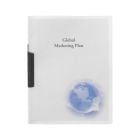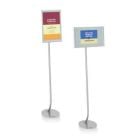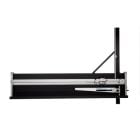A Chat with Graphics Systems, Inc

Recently Tarragon and Chelsea had a chance to chat with the President and CEO of YESGSI,Denny Kopcial. With a sweet southern drawl and the voice of a seasoned professional, Denny answered our many questions about his small, 12-person company in Memphis, Tennessee. He started this print brokerage over 30 years ago, incorporating in 1979. Here's an inside look at Graphics Systems, Inc.
How did Graphics Systems get started?
I was working for a national appliance company running their distribution center. The company moved locations, but I liked the Memphis area and wanted to stay. I went to work for a friend and learned the printing industry. When it became apparent that there were plenty of family heirs moving up in the business, I left to start my own and thus Graphics Systems was born.
GSI has been in business for a long time. How has your business changed over the last 30+ years?
We started this company focusing on business forms, more on the printing side. The industry has changed over the years, not as many people using dot matrix or line-fed printing. We've moved into more commercial and digital printing. Forms are still sold, just not as many.
What advantages do you enjoy by operating a brokerage versus print shop?
As a print broker, we're primarily a sales force, we operate a distribution. We have more flexibility than we would if everything was done in house. No matter what the job is, we are able to find a printer to match the need and capacity to get it done. Often the key factor on a job is who can do it the best and keep the customer happy.
Do you focus primarily in Memphis or do you have a nation-wide customer base?
We find it to be easier to maintain our business locally, so we are able to physically see them and sit down to discuss their needs. We also have quite a few customers outside of our geographical area, mainly from clients who moved or referrals.
What type of business do you typically draw?
Our business varies greatly. We have clients that order four foot diameter forms for high speed printers, which looks like two jumbo rolls of paper that weigh three tons each. On the other side, we have orders of 100 business cards or envelopes. We sell large quantities of warehouse forms, packing slip materials, and forms. One especially large client in hardware distribution consistently orders pricing tickets and labels. We also work with several schools and universities doing marketing materials for recruiting.
Have you ever done any printing, binding, laminating in-house?
At one time we had a digital print shop and did a lot of binding. We used perfect binding, spiral binding, GBC binding, all depending on the need and requirement of the job. They all have their place and there is a cost associated with each different kind of binding. We bound training manuals, classroom textbooks. We eventually sold the digital business to another digital printer, which is now our primary outsource for digital. When the digital shop went away, it didn't make sense to do binding anymore.
How have you seen the print industry change over the years?
There has been a shift from business forms into more commercial printing, getting away from technical mundane invoices and packing lists. Usually there are proofs involved now. Jobs are smaller, dollar wise, but we see more of the glamorous side of printing. There's a larger number of smaller jobs processed, rather than fewer high quantity orders.
What has made you stay with print all these years versus going into something else?
We've maintained a nice book of business with sales volume close to four million. There are plenty of printing jobs; not the same business but plenty of it. We've embraced technology and value the ability to see what's next. It's great when you can present new solutions to your customers without them needing to ask.
What do you love about print?
It's a technical industry, every time you do a job it has to be 100% right. The resulting product has an application. Everybody needs printing, it's really amazing. Some of the best opportunities are in the biggest pains. For example, business cards can be a hassle. But if you can find an efficient way to produce them, it's a nice money maker and they're constantly being used, everyone wants one. The commercial printing side offers more glamor and glitz. You work with agency or marketing department to put their best foot forward. It's really rewarding to see your work out in public.
What's coming on the horizon that's exciting?
I see in the future more and more the use of beyond bar codes – QR codes on almost everything, smart chips implanted in printing pieces, invoices, and packaging to follow shipment for tracking. Printing is getting smarter and carries more info with it. Currently a smart phone can tell you about the specials in a store you just walked by, print can do the same and we will see more of that.
What do you say to the idea that print is dead?
Absolutely not true across the board. Magazines are a prime example. Subscriptions use to cost a fortune, now they're almost all free or at least very cheap. It goes through cycles just like anything else. We may lose newspapers but there will still be plenty of print out there. In the printing industry, we never thought of ourselves as providing information but that is what we do. We need to look at different ways of how to provide that information. Print will always be out there, maybe not as big. There is always more information from different methods. Change your focus on new ways get information. It's amazing the info you can get from twitter. Younger generations looking for different things than people in their 60s.
How does youth play a part?
Our sales people have gotten younger as purchasers have gotten younger. They can relate to current things relevant in each others lives. Matching sales efforts to your audiences helps build confidence in your client.
What is your favorite part of working in the print industry?
Getting a big job and pulling in a lot of pieces to it – the technology side, bar codes, getting everyone together. I love when printers and designers come up with a piece that works for everybody and the satisfaction that comes from putting all the pieces together. For example, we had a customer recently who wanted a label on their packages with an advertisement shown once the label was peeled off. We were able to accomplish it. It gives you a good feeling to be able to accomplish something that hadn't been done before.
What advice would you give to someone looking to get into the printing industry?
Print has a lot of opportunities, every business is a potential customer. It's probably more of a blue collar industry as opposed to a glamor industry. Not as fancy as the advertising agency, but can be more lucrative. If one is willing to learn the business and how to provide solutions, they can be extremely successful.









